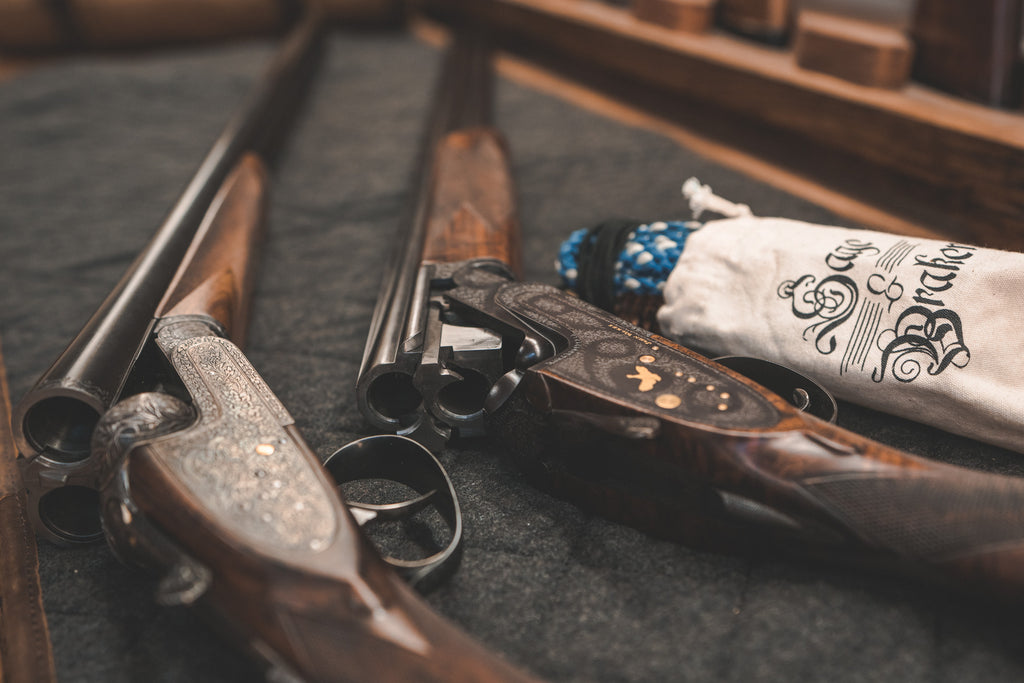Side-by-Side vs. Over-Under? Which Shotgun is Right For You?

Side-by-side or over-under shotgun? Is one better than the other? Which will fit your needs better? Chances are you’ve put some thought into this already. Unfortunately, there is no answer to this question that will cover everybody. It depends on what the user plans on using it for that will dictate what's best for them.
The Advantages of the Double Barrel Shotgun
Both the side-by-side and over-under have two barrels. This configuration has many advantages over the auto-loader and pump shotguns on the market. The most significant benefit to having two barrels is combining two choke arrangements. A more open choke is found in one barrel for closer shots and a tighter one for those farther follow-up shots. This versatility proves vital when out hunting the uplands.
Next, the handling characteristics of double shotguns are far superior to that of pumps and autoloaders. The action length is much shorter, allowing you to have longer barrels in a gun that is shorter in overall length. This shorter action length puts the weight in a more confined area, making it balance and ideally come up to the shoulder.

Lastly is reliability. Autoloaders are notoriously picky regarding various shotshell charges, and although far less common, pump guns do have the occasional hiccup. With a double-barreled shotgun, you have two separate firing mechanisms for each barrel, meaning that if one misfires, you still have the other.
A double-barreled shotgun is a versatile tool for the hunter and target shooter. Many options are available today, and there are important things to consider when deciding whether a side-by-side or over-under is better for you.
Read more on the Double Barrel Shotgun here.
Things to Consider
The factors listed below are not meant to give you a plain answer. Instead, they make you think through your specific scenarios and help you decide which might be right for you. Some may not even apply to you. Carriability, for example, won’t matter as much to someone going a mile or two a weekend chasing stocked pheasants. On the other hand, that can be the most important factor for the western plains grouse hunter that walks ten miles without raising his shotgun for a shot. So take all of these, think through them in your own scenarios, and have fun with them.
Sight Plane
The side-by-side or SxS shotgun is often referred to as the traditional hunting shotgun as it has been around a long time. The barrels are oriented laterally next to each other or side-by-side. This creates a wide sight plane that is ideal for thick cover. This is why many ruffed grouse hunters use them in heavy clear cuts. This wide sighting plane makes it easy to shoot in the grouse woods.
Some shooters dislike the sight plane on side-by-sides as they feel it gives them an illusion of looking uphill. This is very prevalent in a .410 side-by-side. They will almost appear to be bent upwards. This is sometimes countered by using a raised rib. However, raised ribs are not that common.

The sight picture on an over-under is much like that of pumps and semi-autos. If a shooter is familiar with using either of these, that might be a better option. On the other hand, the single-barreled sight picture is preferred by those shooting clays. Preferred is an understatement. The single sighting plane is the only style you will find being used by Olympians today. However, that shooting style is hardly relatable to being used in the field. After all, much of upland shooting is done by point shooting instinctively, not necessarily aimed.
The precise sight picture of an over-under is perfect for a clear backdrop but can become very difficult to use when brush and vegetation are your backgrounds. This problem magnifies when smaller sub-gauges like .410 or 28-gauge are used. On the flip side, those smaller gauges can hit targets with unmatched precision in a more open environment.
The Mount
Sight picture isn’t everything. In hunting scenarios, the mount is as important, if not more important, than the sight picture. The mount, or how it comes up to the shooter's shoulder, can make all the difference on a fast-flushing bird. Much of how well a gun mounts comes down to the stock measurements and how much that particular shotgun will fit you. This isn’t specific to side-by-sides or over-unders but to each individual gun. One Ruger Red Label may fit you perfectly, while another may not.
The stock’s dimensions and style will play a big part in that. Most shotguns sold in America have standard dimensions that will fit the majority of adult males ok. Ok is good enough for most people, and practice will compensate for it. The style of the stock is another important factor to consider. On side-by-sides, some can’t stand the little splinter-style forearm and prefer the beefy wrap-around beavertail. Comb, grip, and forearms vary widely with each model and feel very different. Find what you feel is the most comfortable.

To get the most out of a shotgun’s mount, the individual must learn how to mount a shotgun properly. Whether that means reading a book or attending the local sporting clays event and asking someone to teach you. Once you know how to mount a shotgun, you can go to the sporting goods store and try various models to see which one fits you the best. When you find the one that comes to your shoulder and the bead is right where you want it without adjusting your head, buy it.
Triggers
The SxS shotgun generally comes with two triggers. While there are some that have single triggers, the vast majority have two. Some see this as a disadvantage, but I see it as a huge advantage. First is the simplicity of the design of two triggers. Double triggers are purely mechanical, a series of levers.
In contrast, most single triggers work on an inertia system that can cause issues if the shotgun isn’t mounted correctly, similar to an autoloader. Double triggers make it nearly impossible to mistake which barrel you are shooting out of. The front trigger tends to shoot the more open choke, and the rear the tighter one.

There are several advantages to single triggers. First is the ability to have any style grip. A sharply curved pistol grip does not do well with double triggers, as the hand has to move back slightly when engaging the rear trigger. Next, your hand position is consistent, and there is no need to find a second trigger in the heat of the moment. Both of these should not be overlooked by the potential buyer.
Your preferred trigger style may single-handedly dictate which shotgun you buy and, in my opinion, should not be a deal breaker. It may be as hard to find a single triggered side-by-side as it is a double-triggered over-under.
Carriability
The last thing to consider when choosing between a side-by-side and over-under is carriability. This is 100% based on what the shooter is looking for. Weight plays the most prominent part in this scenario. A ten-pound shotgun is never fun to carry in the field, but a five-pound gun may be too snappy and swing too fast when making a shot. The shooter is looking for a suitable happy medium between the two.

The carriability also refers to the balance of the shotgun. It will be awkward to carry and mount poorly if it is front-heavy or heavy in the butt. So I rotate between taking two guns afield, a 20-Gauge Ruger Red Label and a 16-Gauge Browning Sweet Sixteen. The Sweet Sixteen is light and can be carried all day, but I don’t shoot it as well as the Red Label. This usually leads to me deciding based on how long my hunt will be. If I’m going all day, the 16-gauge is my preferred shotgun. The Red Label will be with me if heading out on a short evening hunt. I think side-by-sides tend to carry better in the field than over-unders.
Finding What’s Right for You
Choosing between a side-by-side and over-under is complicated. There are many things to consider and think about, but it should be looked at as a fun process. Both types of double-barreled shotguns are classics in the field and are meticulously made by craftsmen from all around the world. Going through this thought process, you may find that you need one of each to be sure!
Written by Kurt Martonik
